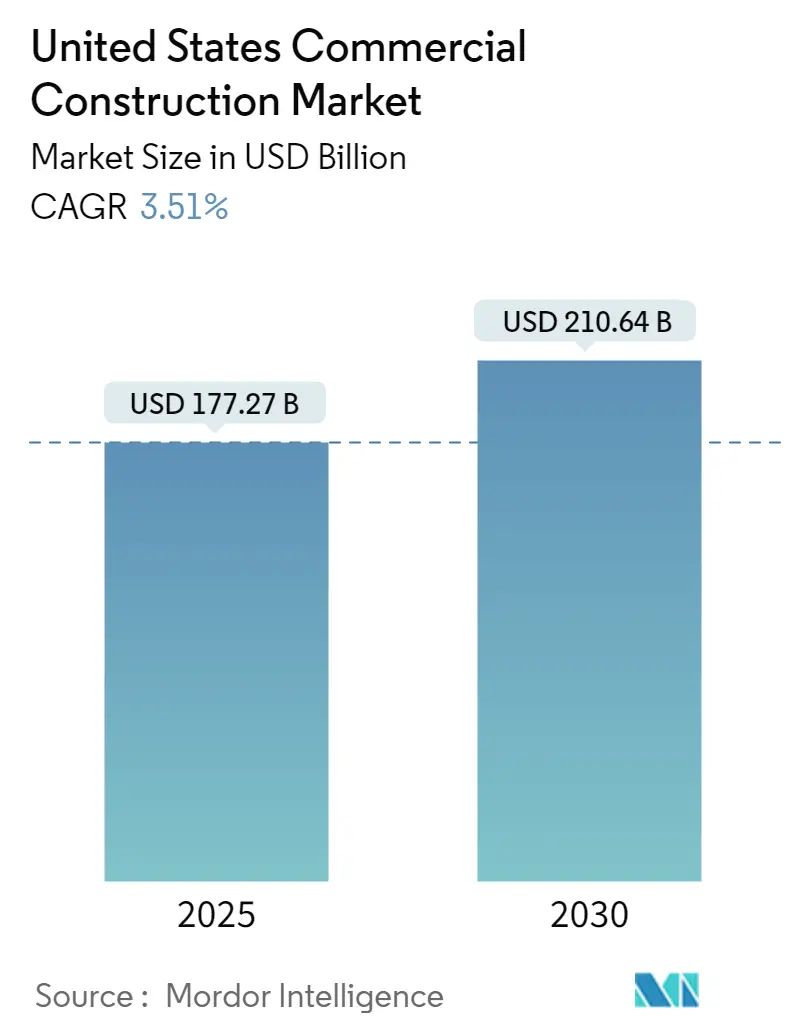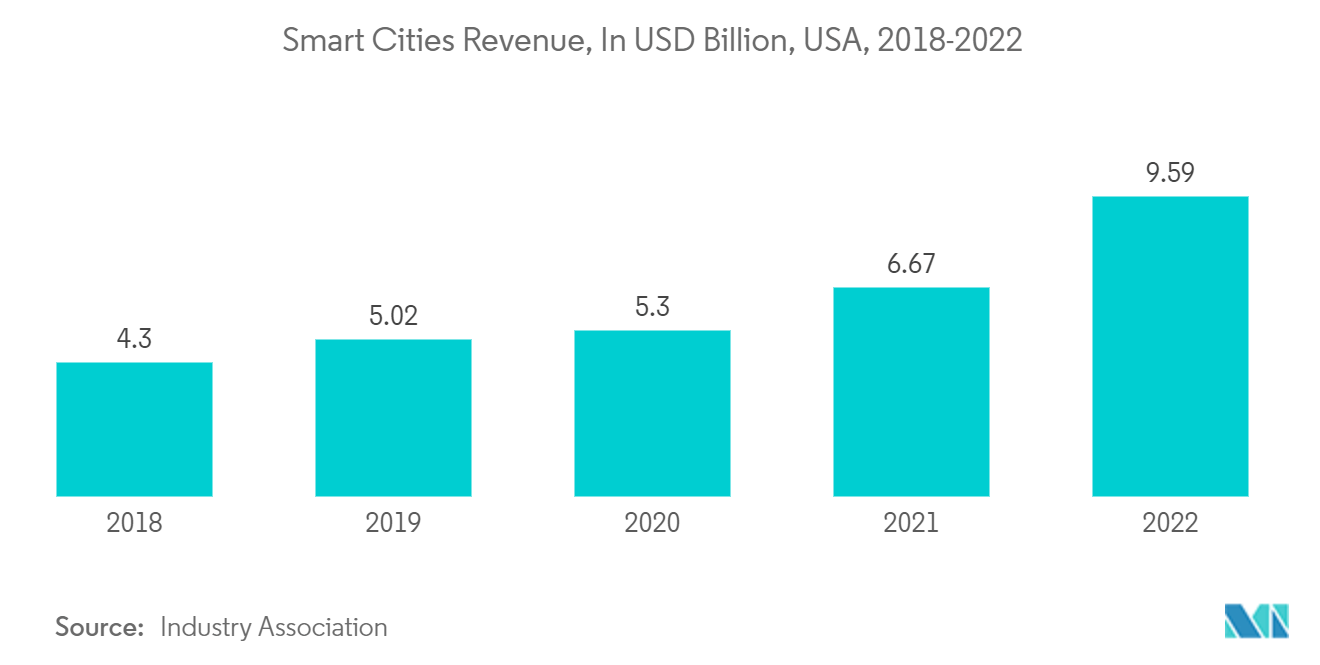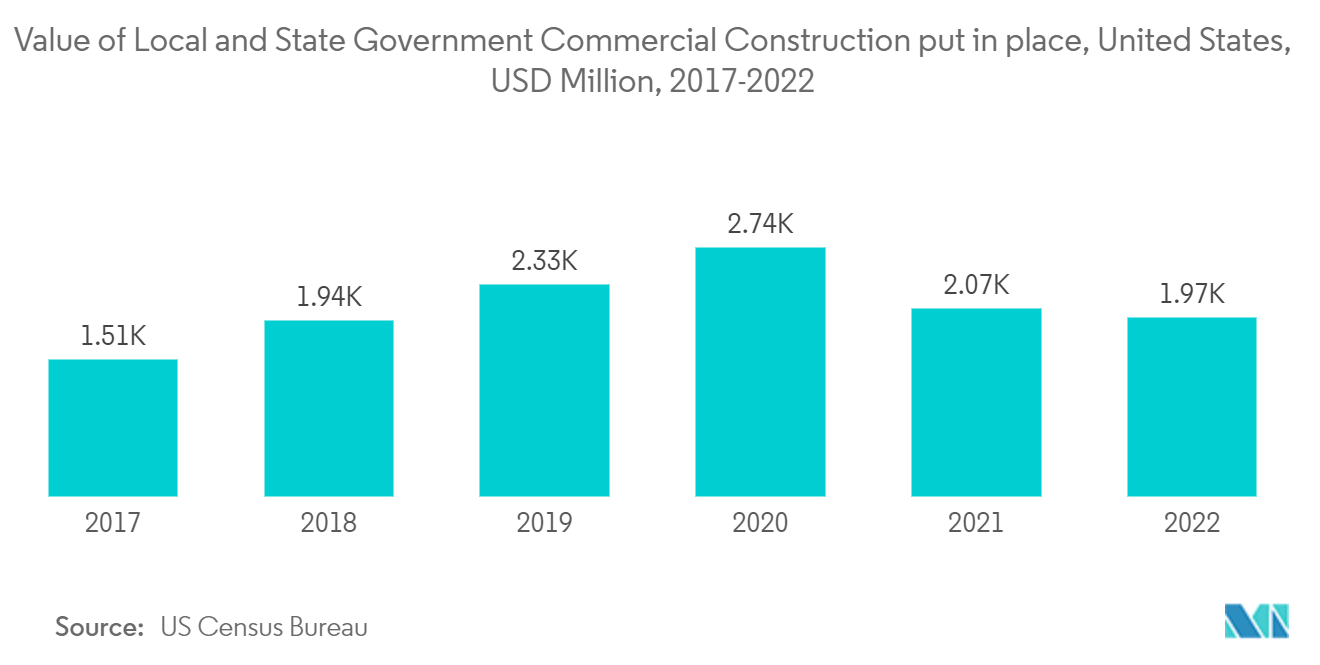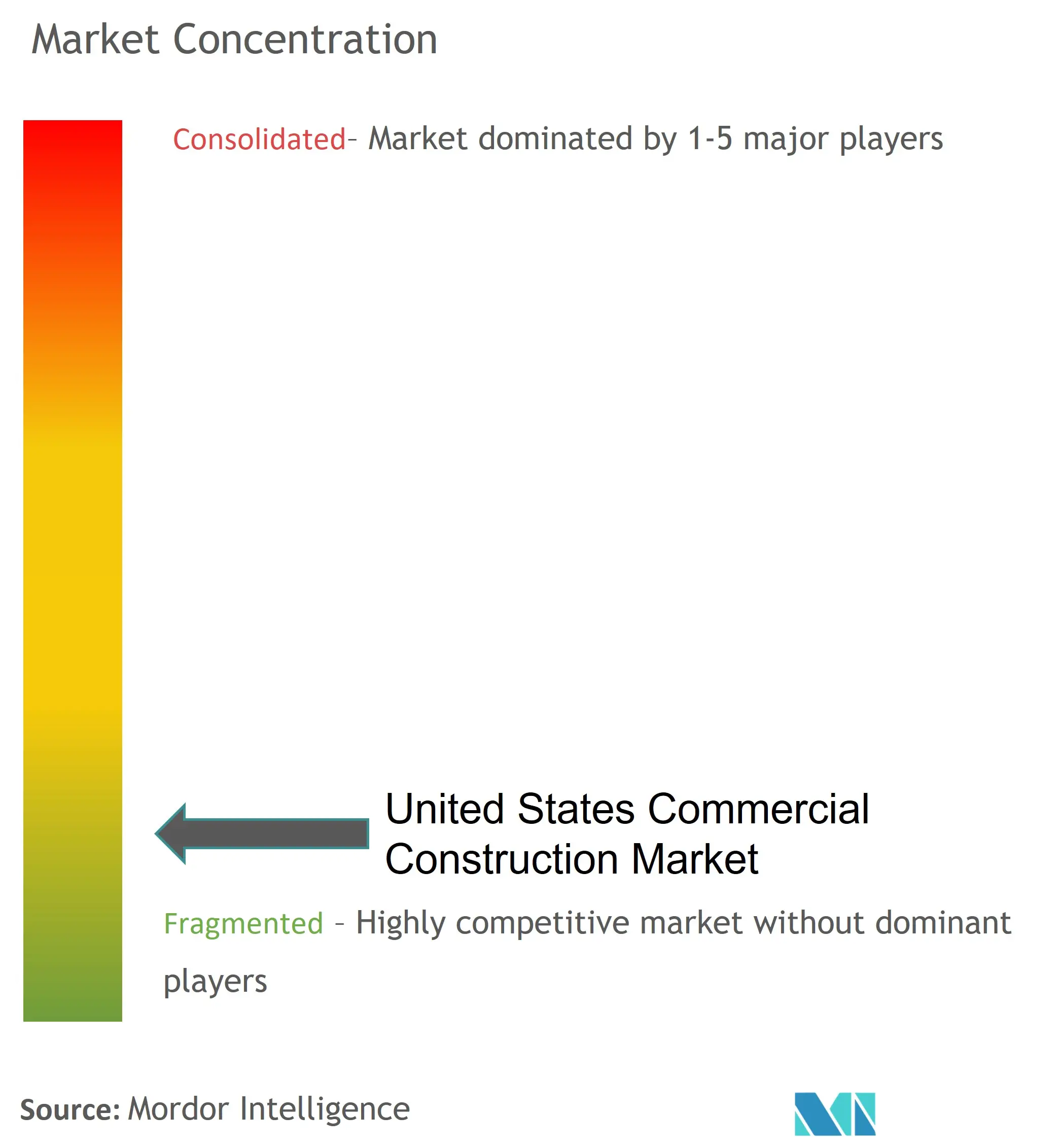US Commercial Construction Market Analysis
The United States Commercial Construction Market size is estimated at USD 177.27 billion in 2025, and is expected to reach USD 210.64 billion by 2030, at a CAGR of 3.51% during the forecast period (2025-2030).
Despite inflation and labor shortage, the demand for commercial real estate continues to drive the market. Furthermore, the market is driven by the huge investments pouring into infrastructure building in the country.
- Overall, the commercial construction industry had a good year in 2021. Construction spending increased due to high spending in residential construction; however, the non-residential segment fell for the second year in a row. Construction firms also had to deal with ongoing labor shortages and delays in receiving building materials due to supply issues and rising material prices. Through November 2021, construction spending totaled USD 1.46 trillion, setting the year to another record-high for construction put-in-place.
- Infrastructure spending will be one of the top areas for growth in construction in 2022. With the USD 1.2 trillion Infrastructure Investment and Jobs Act, Congress finally passed a long-term infrastructure bill after years of stopgap measures and short-term spending bills. Over the next five years, the federal government will invest USD 550 billion in new infrastructure construction and repairs to existing infrastructure. The bill proposes investing USD 110 billion in roads, bridges, and infrastructure projects, USD 40 billion in bridge repairs and replacement, USD 39 billion in public transportation, USD 66 billion in passenger and freight rail, USD 65 billion in broadband internet, USD 65 billion in electric grid reconstruction, and USD 55 billion in water infrastructure.
- During the pandemic, the non-residential building market did not see a similarly dramatic increase in construction services. To be sure, some industries experienced rapid growth, such as warehouses and data centers, but these were offset by more pervasive laggards, such as office buildings and hotels. Construction, like so many other industries, was harmed by brittle supply chains and a shrinking labor force. Building material prices skyrocketed, with lumber, for example, rising as much as 264% from pre-pandemic levels at one point. Furthermore, product lead times continued to skyrocket, with three and four times the pre-pandemic rates not uncommon. To combat rising prices, the Federal Reserve has raised the federal funds rate aggressively, with four hikes in 2022 to date.
- According to the resources, inflation and lead times for certain building materials are finally easing. Construction spending in six sectors-manufacturing, highways, transportation, multifamily housing, lodging, and communications-is expected to increase by at least 5% in 2023, according to the firm. Other sectors, including healthcare, public safety, education, and commerce, are expected to grow by 0-4%. Lead times for other materials, such as architectural interiors, lumber, and plumbing, have also decreased. In the case of plumbing pipes, raw material availability has improved, production has increased, and residential construction demand has decreased.
US Commercial Construction Market Trends
The Emergence of Smart Cities is a Key Market Trend
New York City is currently ranked as the second smartest city in the world and is one of the most prominent Smart Cities. The main innovation of the city can be identified by the form of the transportation and communication linkages. In Smart Cities, the management of operations involves the integration of data and communication, as well as the utilization of the most up-to-date technologies. The development of Smart Cities leads to the creation of functional areas, such as Transportation, Traffic Management, Energy Efficiency and Sustainability, and Governance. The increasing number of Smart City projects across the United States will necessitate the construction of sophisticated road network systems, thus creating growth opportunities for vendors in the market.
For instance, in October 2022, Honeywell's Accelerator Program for Smart City Strategic Planning announced that it is partnering with Acceleration for America to help cities plan for their future and build the capacity to fund transformative initiatives. In-kind support will be provided through Honeywell's Smart Cities Accelerator Program, which is a partnership between Honeywell and Acceleration for America. The Acceleration for America program is designed to accelerate progress in cities' strategic planning efforts. The Honeywell Smart Cities Acceleration Program is a partnership between Acceleration for America (AFA) and Honeywell (Honeywell), which is a subsidiary of Honeywell Inc. (Honeywell). Five U.S cities have joined the Acceleration for America: Cleveland (Cleveland, OH); Louisville, KY; Kansas City, MO; San Diego, CA; Waterloo, and Iowa.
Each city will receive Smart City Strategic Plans (SCPs) through Honeywell's and Accelerator's technical support. Each SCP aligns key stakeholders, sets priorities, and identifies high-impact, inclusive initiatives that improve residents' quality of life (QoE) in areas like climate resilience, public safety and operational efficiency, and enhanced service delivery. Each city will also be supported in applying for Federal grants to help implement identified projects.
Office and Retail Space Driving the Market
In March 2022, 144.7 million square feet of office space were under construction in the United States, accounting for 2.2% of total stock. Notably, half of that pipeline will be provided in urban submarkets outside of key business areas. Furthermore, 93% of the space is Class A or A+, indicating that businesses are continuing to prioritize high-quality projects to retain their workforce.
In March 2022, Austin, Texas, had 10 million square feet of office space under construction. This represented 11.5% of the city's current stock, while planned projects represented 25.3%, the highest percentage among major cities. This comes after Austin outperformed all other markets in 2021 in terms of office-using job growth (14%), as well as new development (5.3 million square feet). In contrast, construction in Denver and Phoenix slowed due to the pandemic and massive pre-pandemic deliveries; between 2015 and 2021, each city added more than 16 million square feet of additional supply. In March, both cities had slightly more than 1 million square feet of office space under construction, accounting for slightly more than 0.8% of total stock.
US Commercial Construction Industry Overview
The US Commercial Construction Market is fragmented and highly competitive, with the major local and international players creating a highly competitive environment in this sector. However, the market opens opportunities for small and medium players due to increasing govt investments in the sector. Major players in the market include Gilbane Building Company, MA Mortenson Company, Balfour Beatty LLC, Hensel Phelps Construction Co., McCarthy Holdings Inc., and Tutor Perini Corporation. The market presents opportunities for growth during the forecast period, which is expected to drive market competition further. Large players competing with others for a significant increase in market share leaves the industry with no observable levels of consolidation.
US Commercial Construction Market Leaders
-
Kiewit Corporation
-
Hochteif Construction
-
Gilbane Building Company
-
MA Mortenson Company
-
Balfour Beatty LLC
- *Disclaimer: Major Players sorted in no particular order
US Commercial Construction Market News
- Dec 2022: Global Infrastructure Solutions Inc. (GISI) and Hill International Inc. (NYSE: HIL) announced that their strategic merger had been completed following the completion of final regulatory reviews. This merger expands growth opportunities globally for fee infrastructure consulting markets.
- May 2022: Hyundai Motor announced in May 2022 that it would break ground on its new facility in Georgia in early 2022, with an annual capacity of 300,000 EV units, with commercial production beginning in the first half of 2025. According to an unnamed auto industry source, Hyundai Motor is considering starting construction later in 2023, with commercial production beginning in the second half of 2024.
US Commercial Construction Industry Segmentation
Commercial construction is the business of constructing and leasing or selling private-sector spaces. Offices, manufacturing plants, medical centers, and retail shopping centers are all of which constitute examples of such spaces. The size and scale of commercial construction projects and businesses vary greatly.
The US Commercial Construction Market is segmented By End Users (Office Building Construction, Retail Construction, Hospitality Construction, Institutional Construction, and Other End Users). The report offers the market size in value terms in USD for all the abovementioned segments.
| By End User | Office Building Construction |
| Retail Construction | |
| Hospitality Construction | |
| Institutional Construction | |
| Other End Users |
US Commercial Construction Market Research FAQs
How big is the United States Commercial Construction Market?
The United States Commercial Construction Market size is expected to reach USD 177.27 billion in 2025 and grow at a CAGR of 3.51% to reach USD 210.64 billion by 2030.
What is the current United States Commercial Construction Market size?
In 2025, the United States Commercial Construction Market size is expected to reach USD 177.27 billion.
Who are the key players in United States Commercial Construction Market?
Kiewit Corporation, Hochteif Construction, Gilbane Building Company, MA Mortenson Company and Balfour Beatty LLC are the major companies operating in the United States Commercial Construction Market.
What years does this United States Commercial Construction Market cover, and what was the market size in 2024?
In 2024, the United States Commercial Construction Market size was estimated at USD 171.05 billion. The report covers the United States Commercial Construction Market historical market size for years: 2020, 2021, 2022, 2023 and 2024. The report also forecasts the United States Commercial Construction Market size for years: 2025, 2026, 2027, 2028, 2029 and 2030.
Our Best Selling Reports
US Commercial Building Industry Report
The US commercial construction market is poised for significant growth, driven by various factors such as economic and population growth, urbanization, technological advancements, and government regulations. Key market segments include office buildings, retail spaces, hospitality establishments, healthcare facilities, educational institutions, and industrial buildings. The commercial construction market in the US is further segmented by project scope, including new construction, renovation/remodeling, and expansion/addition, as well as by construction methods like traditional and prefabricated/modular construction. End-user industries span corporate, retail, hospitality, healthcare, education, and industrial sectors. The market continues to thrive due to ongoing investments in infrastructure and the emergence of smart cities. The competitive landscape is fragmented, offering opportunities for both large and small commercial construction companies to capitalize on the growing demand for commercial real estate. Statistics for the US commercial building market share, size, and revenue growth rate, created by Mordor Intelligence™ Industry Reports, provide a comprehensive analysis. The US commercial building analysis includes a market forecast outlook and historical overview. Get a sample of this industry analysis as a free report PDF download.

_-_Copy.webp)





